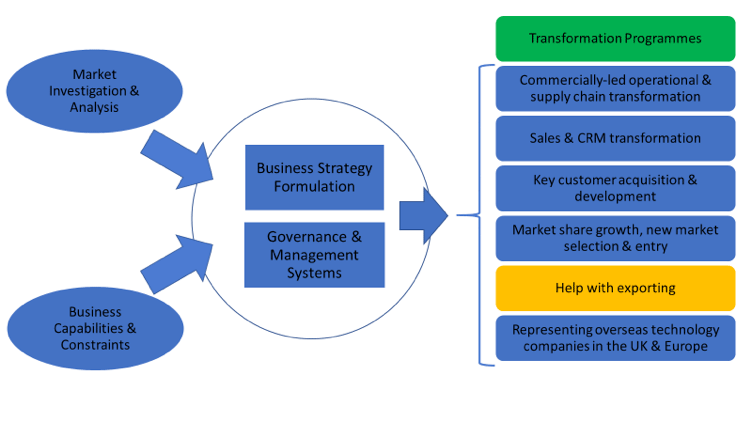Help with Exporting

Help with Exporting
Help with Exporting
Developing export markets can be a powerful route for companies to grow profitable sales of existing products & services, with export market localisation costs and risks often being much lower than the alternative growth option of entering new market sectors and developing new products & services.
An effective strategy requires careful selection of the right export markets; the right channels to access them; and robust, high integrity commercial processes to protect the business.
Sales Nova’s interim executives possesses deep expertise in export market selection, market access channel selection, export commercial processes, market entry and growth. They have personally led this activity for significant parts of their career, with several currently living and working in export markets.
Our interim executives possess European Arabic, Japanese and Mandarin Chinese language skills facilitating access to markets in the Europe, Middle East, Africa, India, Far East and Southeast Asia.
Sales Nova’s Export Market Development Approach
Our approach builds on a solid understanding of a company’s markets, core capabilities, the aims of its shareholders, and its business strategy. We engage closely with shareholders & senior management to help them see where exporting may fit into their strategy, and whether the ultimate aim is to open local offices in export markets, access markets through agents & distributors, or to acquire a few key customers whom they will support remotely from head office or by a regionally based territory manager.
Our five-step approach is as follows:
- Validation
- Phase 1 selection & short-list
- Phase 2 selection & short-list
- Channel selection & market entry
- Ongoing support & growth
Validation
We identify potential show-stoppers such as:
- Export restrictions;
- Logistics costs & how well the product stacks;
- Whether the key propositions such as brand, technical know-how, and barriers to manufacturing the product, or offering the service, are sufficient that overseas markets would buy from overseas.
- Whether costs to local
From this initial work we are able to recommend to senior management whether or not they should progress to investigate export markets.
Phase 1 Selection & Short-List
We undertake an initial desk-based mapping of export market size and addressability for the Company’s propositions:
- Sales Nova has access to data that almost always achieves this without the need to purchase expensive sector-specific market reports.
- We will also consider factors such as import duties, risk of bribery & corruption, and physical safety of operating in a country.
- We identify and speak with aligned but non-competing companies operating in export markets, who may be willing to offer guidance.
From this work produce a first-cut shortlist of countries recommended for detailed investigation, which we review with senior management to agree the export markets that will be investigated for phase 2 selection.
Phase 2 Selection & Short-List
For the agreed first-cut shortlist of countries we investigate the following:
- Detailed market size, segmentation & environment; local factors for success & company differentiating selling propositions; competition; price points; transport costs; import duties and taxes; and estimated support costs.
- The nature of the customer base, key influencers (e.g. trade bodies, Governments) and suitable channels to access the market segments in line with the company’s strategic aims for export markets.
- Where agents & distributors are appropriate, we will identify & meet with suitable ones, selected for market knowledge & reputation, and so the fee / margin from the export business could make a significant contribution to their profits, and thus motivate them to promote the company.
- Product localisation, testing and certification requirements and costs in order to sell in the country.
- Operational ability of the business to meet export market demand & SLAs and working capital & financial implications & risks.
- Potential impacts of foreign exchange movements on margins.
Some of this work takes place remotely, but in market work is usually involved and is undertaken either by one of Sales Nova’s partners based in the local market, or by a Sales Nova interim executive visiting the market. Visits to markets will include trade-shows where possible and make use of Chambers of Commerce and British Embassies to maximise the effectiveness of visits whilst keeping cost and duration to a minimum.
From these enquiries a go/no recommendation can be made to senior management, and where viable, business plans developed for market entry, subject to Board approval. We apply a PMO programme management approach to this activity, managing risk & ensuring export market entry business plans are in line with available resource capacity to deliver sustainable results. This typically results in the progressive phased development of a number of export markets over time, ensuring each market is sustainably developed rather than spreading resources too thinly. Clients are often over-ambitious initially due to under-estimation of resource requirements; our approach retains the ambition but ensures a sustainable pace of delivery.
Channel Selection & Market Entry
Subject to senior management approval we would then plan for export market entry & launch, creating & delivering
- Commercial processes to manage risk & compliance including sales policy & process; bid/quote & order/contract due diligence pre-acceptance; export documentation & licensing; “Know Your Client” UK Bribery Bill & US FCPA and related compliance; commercial contracts with emphasis on security of payment; INCOTERMS of carriage; and warranty.
- Systems for channel partner (agent & distributor) selection, integrity checks, contractual appointment, training, reporting, forecasting & performance management, and clear legal & financial positions over contractual & termination risks & liabilities.
- The creation, training & coaching of export sales & customer support teams with service delivery (e.g. languages spoken; hours of work) aligned to support new export markets.
- Actual selection & contractual appointment of agents & distributors, or the setting up of a direct local presence in the market / region, with local legal, banking & accounting advice as required.
- Product localisation engineering, testing & certification to meet market requirements.
- Selection of logistics provider & customs brokerage to achieve optimum shipping costs and customs classification codes to minimise import duties and taxes.
- In-market launch strategic plan with clear timelines, budgets & KPIs, including agent & distributor sales & support training, product & spares stocks, brand integrity, marketing mix & selling tools, key customer contact programme, and growth of sales pipeline.
Ongoing support & growth
- Optimisation of territory visits to motivate agents / distributors to focus on selling the company’s propositions, and act when performance is not acceptable despite measures taken to improve.
- Coaching and development of the company’s export sales & customer support team.
- The development of web-based support & training tools and CRM (e.g. CPQ systems), to improve accessibility and reduce the cost of support.
- Optimisation of the sales process:
- to fine-tune focus on prospects whose attributes align well with the differentiating export proposition; and
- to improve the quality of agent & distributor forecasts as inputs to SIOP operational demand planning.
- Review of channel to market strategy as export market business grows & matures over time.
Development


